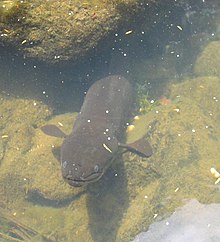New Zealand longfin eel
| New Zealand longfin eel Māori: tuna |
|
|---|---|
 |
|
| New Zealand longfin eel at the base of a waterfall near Piha beach, Waitakere Ranges, Auckland. |
|
| Scientific classification | |
| Kingdom: | Animalia |
| Phylum: | Chordata |
| Class: | Actinopterygii |
| Order: | Anguilliformes |
| Family: | Anguillidae |
| Genus: | Anguilla |
| Species: | A. dieffenbachii |
| Binomial name | |
|
Anguilla dieffenbachii J. E. Gray, 1842 |
|
|
|
The New Zealand longfin eel (Anguilla dieffenbachii) is the largest and the only endemic freshwater eel species in New Zealand. (The others are the native Shortfin eel, Anguilla australis, also found in Australia, and the naturally introduced Australian Longfin eel Anguilla reinhardtii). Longfin eels are long-lived, migrating to the Pacific Ocean near Tonga to breed at the end of their lives. They are good climbers as juvenile and so are found in streams and lakes a long way inland. An important traditional food source for Māori, longfin eels are threatened and declining but still commercially fished.
The easiest way to identify the longfin eel is by the length of its fins: the dorsal (top) fin is about two-thirds the length of the body and starts significantly further towards the head than the anal (bottom) fin. In the shortfin eel the fins are of similar length. When a longfin eel bends its loose skin wrinkles distinctively inside each bend, where a shortfin eel's skin is smooth. A longfin's mouth extends past its eyes, further than a shortfin's.
Female longfin eels are larger and longer-lived than males. Males average 66.6 cm but reach up to 73.5 cm in length, with an average age of 23 years (12–35 years). Females are considerably larger, ranging from 73–156 cm with an average length of 115 cm. Females attain an age of 20 to 60 years before migrating to sea to breed. Longfin eels in the North Island migrate at a younger age and thus have faster generation times.
Determining longfin sex is difficult as their sexual organs are not determined until they are over 45 cm in length. The only method to determine longfin eels sex is through internal examination and only becomes easy to distinguish when the eels mature and migrate.
Like other members of the Anguillidae, longfin eels have a rather unusual life cycle: they grow and mature into fertile adults in fresh water, then migrate to the sea to breed. This catadromous breeding system also ensures randomised mating, creating a panmictic population.
...
Wikipedia

